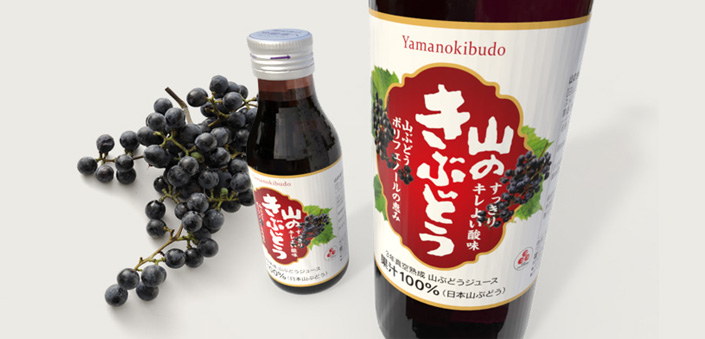▶ About Crimson glory vine
▶ Our Principles
▶ About Sakohonten
▶ About Company Vineyard
▶ How to Enjoy

Development story(1)
Development Story of “Yama-no-Kibudo”
First encounter with Crimson glory vine
It was a totally unexpected encounter. Kokichi Sasaki, the founder of Sakohonten Co., Ltd., first came to know Crimson glory vine by accident, and this led him to create today’s “Yama-no-Kibudo,” 100% pure non-additive and not-from-concentrate grape juice. Around 1940 – 1942, when he was peddling among mountain villages in Kuji, Kokichi happened to stop by a house where a young wife was on the point of giving birth. He heard a midwife saying, “A baby was born safe and sound. Bring Crimson glory vine juice and give it to the mom.” Kokichi thought Crimson glory vine juice must be very good for one’s health. At this moment, he was believed to have determined to make Crimson glory vine juice widely available on the market.
Starting the production of Crimson glory vine beverage
After the Second World War, Kokichi’s juice making began. Using a jute sack and a weight, he extracted juice from Crimson glory vines, which he bought from his neighbors. In 1955 he, using thus extracted juice as a base, developed beverage which had 10% fruit juice. He dug a well on the premises of his company and used the underground water for diluting the juice. The well water was hard but rich with minerals, which were suitable for making juice. He named his first beverage “Kosen (spring of light) Yamabudo,” because when he looked down into the well, he noticed glistening water surface. Sakohonten has been using this same well water ever since.
Developing 100% pure fruit juice by the request of expectant mothers
Around 1970 he started developing 100% Crimson glory vine juice in responding to the voices from expectant mothers who received advice from their doctors to take Crimson glory vine extract. Kokichi recalled the first encounter with Crimson glory vine and proceeded to produce 100% Crimson glory vine juice. He had to take a thorny path before he finally succeeded in its production. Squeezed juice from Crimson glory vine was less than 100 ml due to small sizes of berries. Moreover the pressed juice had an incredibly bitter taste with a high level of acidity. Kokichi was confronted by many problems.
Producing “Yama-no-Kibudo” with both satisfactory taste and nutrient contents
In spite of the hardship he faced, he spent many days of trial and error and finally created 100% pure fruit juice that did not alter both taste and flavor of Crimson glory vine without additives and alcohol. Kokichi discovered that 3 to 5 years of aging without fermentation created juice with well-balanced bitterness and sourness while retaining the original characteristics of Crimson glory vine. Another discovery was that the aged juice contained 6 times as much mineral (iron, calcium, etc.) as other grapes. It was indeed a gift from nature. In 1971 the company launched production of the first 100% Crimson glory vine juice, not-from-concentrate, and the product was named “Yama-no-Kibudo.” About 20 years have passed since the time Kokichi started soft beverage production. His ardent desire to create 100%, non-additive, and non-alcohol juice with the authentic taste of Crimson glory vine was now realized.
Continuing efforts to place quality before quantity
Kokichi held a belief that beverage that was good for one’s health must also taste great. He developed his own method by which juice goes into aging for 3 years letting tartar acid naturally settle down at the bottom. By this way the bitter and sour taste changes to mild and pleasant one while nutrients are kept undestroyed. The company has been adhering to this method to produce the current “Yama-no-Kibudo.” Sakohonten uses Crimson glory vine harvested only in its own and licensed growers’ vineyards located in Iwate. Harvested vines are carefully pressed and then the extracted juice is aged in vacuum. No added sugar and no additives are used. Sakohonten, unlike other food and beverage manufacturers in Japan, sticks to this time consuming production method.

Squeezed juice
Vast vineyard
Crimson glory vine before changing colors
Sakohonten Co., Ltd.
Products
Beverage Products
Cosmetic Raw Materials
About Us
Company Profile
Copyright © 2023 Sakohonten Co., Ltd. All rights reserved.
